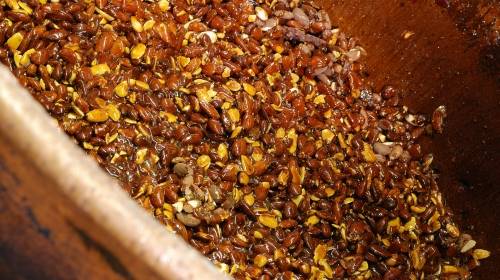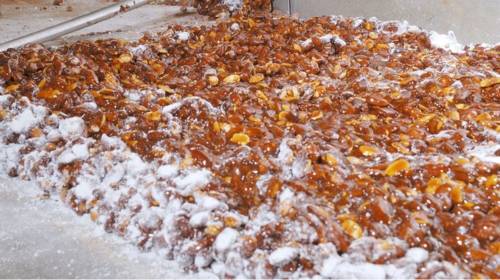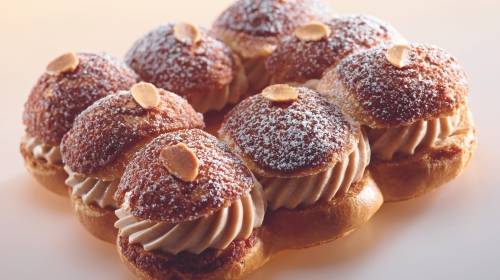Praliné: everything you need to know about this essential treat.
We find it inside chocolates.
In patisserie, it is a key ingredient in classics such as the Paris-Brest.
The story goes that it was created somewhat by chance in the seventeenth century and it said to have been partly named after its patron (César de Choiseul du Plessis-Praslin, ambassador of Louis XIII, don’t you know!).
As you may have guessed, this week’s article is dedicated to praliné.
We’ll explain everything you need to know about this mouth-watering delicacy that excites the taste buds!
Pralines, pralin, praliné…
Let’s start by distinguishing between three distinct terms that look so similar that they are often confused for one another!
In French, a praline is a whole hazelnut or almond coated in caramelized sugar. You could say that it’s the ancestor of the chouchou, a snack that is very popular on beaches in the south of France, except that here the hazelnuts and almonds are replaced with peanuts (which have a similar appearance and nutritional properties to other nuts, but which in fact botanically belong to the legume family!).
Initially, pralines are caramel colored, but they are better known in their pink or even red version. Lyon and Saint-Genix sur Guiers (in Savoie) both claim to be the place where the colorful versions were first created.
In the end, it doesn't matter where they come from: they are a real delight and anyone who has never tasted praline tart in their life should remedy this as soon as possible!
“Pralin” is a mixture of roasted, caramelized and ground almonds and hazelnuts. It takes the form of a powder and brings a crunchy texture and a delicious caramelized nutty flavor to desserts such as cookies, cakes or brownies. It also enhances fruit tarts and lets you spice up traditional panna cotta.
Praliné is made from pralin. Simply blend for longer and more thoroughly, so that the oil from the nuts is extracted and turns the powder into a paste.

How to make praliné
Making praliné is relatively simple. Good nuts, sugar, an oven, a sturdy food processor, a little patience and the that’s all there is to it.
Praliné recipe:
- 100g almonds
- 100g hazelnuts
- 130g sugar
1/ Roast the nuts
2/ Make the caramel
3/ Pour the caramel over the roasted nuts
4/ Break up the caramelized nuts
5/ Blend for 10 minutes in a food processor
Walnuts, pistachios, pecans, macadamia nuts, pine nuts... you can also vary the flavors and prepare your pralinés using other kinds of nuts!
Secrets behind pralinés
The secret to avoid messing up your praliné is to shell the almonds and hazelnuts. In other words, the thin layer covering them must be removed. To do this, Valrhona recommends placing the nuts on a tray and putting them in the oven for about ten minutes at 355°F (180°C) to roast them. Roasting hazelnuts and almonds will dry them out and release their flavors. Once dry-roasted and golden, remove the nuts from the oven and place in a clean dish towel before leaving to cool. A few minutes later, rub vigorously: the nuts will then be removed from their thin layer of shell.
The second top tip to making praliné is caramel. Be careful when cooking it and pay special attention to its color. Too light and it will have no flavor but too dark and it will be bitter. Remove from the heat as soon as the caramel turns amber, as it will continue to heat in the pan afterwards. It won’t be news to you that you shouldn’t touch your caramel once it’s on the heat. You know what they say: stirred caramel is failed caramel.
Okay, we’re rhyming “caramel” with “caramel”… but the point is still correct!
How to store praliné
Keep it in a tightly sealed glass jar out of direct sunlight, and your praliné can be enjoyed for months! Do not hesitate to double the portions when you making pralinés!
What’s the secret behind Valrhona’s praliné?
The other option to obtain a praliné that is perfect and delicious in equal measure is to trust Valrhona and get it yourself here.
Why is Valrhona’s praliné so good? Because it is made in our workshops at Tain l’Hermitage and the recipe has been the same for 90 years!
How is praliné made at Valrhona? A bit like at home, except that here, saucepans are replaced with cooking pots! Here’s how: First of all, just as we do with cocoa beans (See our article: How to choose your chocolate), we select the best nuts. For example, for certain pralinés, we select almonds from Spain or hazelnuts from Italy.
As soon as the cooking process begins, the nuts and sugar are poured into a large pot so that they cook together. This technique is known as sablage in French (which roughly translates as “crumbling”) and it is what gives the warm, full-bodied nutty notes in Valrhona’s Praliné range all their intensity and elegance.
And the cherry on top (of the praliné): authentic caramel, also made in a copper cooking pot, to which nuts are added. The mixture is cooled on a table before it is ground down and refined. This process is the hallmark of Valrhona’s pralinés.

How to use Valrhona’s pralinés
Those with healthy appetites (and those who just can’t wait!) can taste the praliné with a spoon, straight from the pot! Those who want to work with it are spoilt for choice with several easy options. Just adding Valrhona couverture chocolate transforms the praliné into a delicious chocolate spread.
Praliné can also be used to make mousse, sorbets, crémeux and choux .
Feel free to share your favorite praliné recipes with us!

A bit of culture: a brief history of Praliné
Like tarte tatin, blond chocolate (a magnificent invention from pastry chef Frédéric Bau. Dulcey 35% bag and sachet highly recommended) or even ganache, praliné is said to have been created from a happy accident.
Legend has it that Clément Jaluzot (or Lassagne, depending on the version of the tale), a professional chef, was behind the discovery after accidentally dropping an almond into some caramel.
Another version recounts that the same cook took inspiration from a junior kitchen hand that he saw snacking on leftover crushed almonds and caramel pieces...
 Microsoft Edge
Microsoft Edge
 Google Chrome
Google Chrome
 Mozilla Firefox
Mozilla Firefox
 Opéra
Opéra


